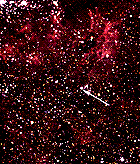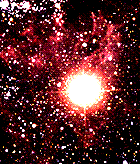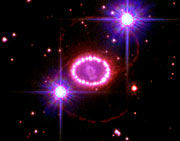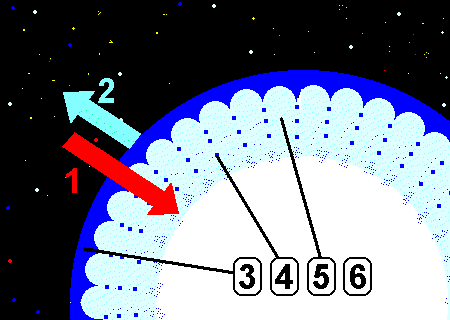Supernovae. Where is the lie and where is the truth? SN 1987A
March 8, 2009. I couldn't start revising this page for a long time. It was written in the spring of 2000.
Reviewing this page is difficult for a number of reasons, the main ones being the following three reasons:
the problem of the star's interior,
the problem of evolution,
the problem of reproduction of civilizations in the eternal Universe.
The problem of the star's interior.
The basis for writing this page was the realization of the idea that the depths of a star can be stripped of matter by radiation pressure.
Can you imagine? Light squeezes matter out of the center of a massive star! Complicated, right? According to Archimedes, denser matter should sink down, and lighter matter should be pushed up. But if we estimate that light at a temperature of about a billion degrees also has a mass density almost ten times greater than the density of water, then the "photon void", with a mass of several tons per cubic meter, is no longer a void at all! This idea of the depths filled with radiation captivated me so much that I soon came to the idea of the Arch Effect. The Arch Effect provided another reason for emptying the depths of a massive object of ordinary matter. I spent several years on its various proofs: logical, analytical, mathematical, historical and software proof. Everything was going well, until the spring of 2008, when I tried to get another proof, a computer model.. Alas, the model of gas, bound by gravity, did not prove either the new, arched theory or the generally accepted archless one. But working with programs showed that the temperature of the interiors of massive stars cannot have those huge values (a billion degrees) that I attributed to the interiors of massive stars before realizing the Arch Effect.
Here are examples of what my program gives, solving a system of differential equations for stars of different masses, and plotting graphs of the main physical quantities: pressure, density, temperature.
Sun-like object: M = 1MSun; R = 1RSun.
|
Our model with Arch effect |
Archless model. |
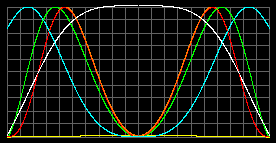 |
 |
| Tcenter = 7.66 millions K. pmax=8.4*108atm at r=0.56R rmax=2.5 tonn/m3 at r=0.632R |
Tcenter=18 millions K. pmax =7.96*109atm at center. rmax=7.8 tonn/m3 at center. |
Yellow is radiation pressure; red is matter pressure; orange is total pressure, green is density, white is temperature, blue is acceleration g. As we can see, the arch model gives us almost zero pressure and zero density at the center of the Sun; the archless model gives almost the same as the standard model described in textbooks. The standard model takes into account nuclear sources, and the system of equations takes into account energy transfer. Our program does not take into account energy sources, but we can independently set the temperature gradient within reasonable limits in accordance with the acceleration g(r).
And what will we get if we run the program for stars with masses greater than the solar mass, for example, 70 times?
M = 70MSun; R = 500RSun.
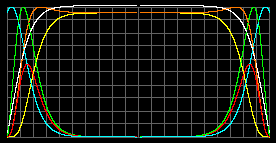 |
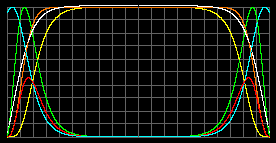 |
| Tcenter = 363 thousand K. pmax. =45 atm at r=0.74R. rmax=1.86 g/m3 at r=0.88R. |
Tcenter = 391 thousand K. pmax. = 58 atm at center. rmax=1.81 g/m3 at r=0,87R. |
Crazy! We see an empty balloon in both models! Look at the archless model - the right graphs. They are almost the same as in our arched model! But the standard model states that the pressure and density maxima are at the centers of stars. But the question arises, are the systems of differential equations in the standard model, burdened with energy sources, convective and/or radiative energy transfers, solved correctly?
Pay attention to the values of the obtained quantities. The temperatures of the interiors of massive stars with large radii are only hundreds of thousands of degrees! Nuclear reactions in such stars are impossible. But what happens if we reduce the radius by ten times.
Take an object with M = 70MSun; R = 50RSun.
We get almost exactly the same graphs, but the temperature will rise by about 10 times, the total pressure will rise by 104 times, because it now depends mainly on radiation. The density will increase by 103 times. Conclusion: The mass of the star plays a decisive role in changing the appearance of the graphs; the radius of the star plays a decisive role in changing the values of physical quantities.
Let's look at objects with parameters close to the pre-supernova SN 1987A.
An object with a mass M = 20MSun; R = 50RSun; m=1,5 amu; dT/dr = -(2/5)mg/k.
 |
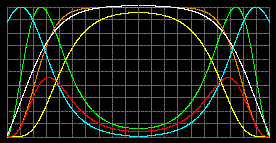 |
| Tcenter = 1.9 million K pmax. = 44 000 atm at r=0,64R. rmax=0,41 kg/m3 at r=0,78R |
Tcenter=2,34 million K pmax. =78 000 atm at center rmax=0,4 kg/m3 at r=0,742R |
As we can see, the radiation pressure has exposed the centers of matter in both models. The supergiant shell has a maximum density about 2000 times less than the density of water. Let's see what happens when the temperature gradient changes and replace dT/dr = -(2/5)mg/k by dT/dr = -(2/3)mg/k.
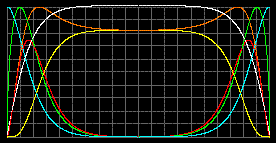
|
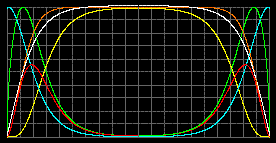 |
| Tcenter = 1 790 000 K pmax. = 32 000 atm at r=0,76R. rmax=0,41 kg/m3 at r=0,9R |
Tcenter=2 100 000 K pmax. = 41 000 atm at center. rmax=0,39 kg/m3 at r=0,89R |
Conclusion: Working with the program showed that in giant stars with masses tens of times greater than the mass of the Sun, a photon cavity arises, both in the arched model and in the archless one. Objects with masses of the order of a hundred solar masses and higher are impossible, since the shell becomes too thin. The temperatures of photon cavities of supergiants are comparatively low, about a million degrees, or even lower.
The Problem of Evolution
This is the second reason, why it is difficult to review this page.
Evolution. Development. Change.
Was there a Beginning?
This is a question that a person asks himself in his youth, and one day, having accumulated knowledge and come close to the answer, he will take one of the mutually exclusive positions, and then he will hardly be able to change his point of view. This is a fundamental worldview question. And it must be answered honestly, based not only on the laws of physics, but also cosmology, biology, and, finally, philosophy.
Since two answers are possible here: "yes", "no", then in science there must be two equal currents. Alas, science has shown its religiosity - the camp of the majority has captured the leading positions in science and cleared the leadership of science from the minority.
The victory was "won" by those who say that there was a Beginning. But are they right - after all, a dispute in science is not resolved by a majority vote. The dispute must be resolved by experiment. But what if the experiment is impossible, or if there is little observational data?
The founder of the Evolutionary Universe is certainly not the swindler from Odessa, who fled to America, George Gamow, not Willem de Sitter, not Friedman, and not the clergyman Georges Lemaitre.
Everything was predetermined much earlier. Rudolf Clausius (1822-1888) analyzed the work of heat engines and, summarizing the first and second laws of thermodynamics, formulated the cosmological principle:
The energy of the Universe is constant.
The entropy of the Universe tends to the maximum.
But this is only a hypothesis! Heat engines are on the surface of the Earth, and there is no need to extend the hypothesis to the entire Earth and the entire Universe. The Earth itself, as a massive object absorbing the energy of the vacuum, can be a "perpetual motion machine". Clausius's contemporaries spoke about the absorption of ether, and could well have spoken about the pumping of the interiors of stars and planets with energy, and, accordingly, about the decrease in entropy in the gravitational process. But what was said required facts and mathematical calculations. Now we can cite many facts. For example, Io, a satellite of Jupiter, is literally teeming with volcanoes! Why? But in Clausius's time, both facts and calculations were problematic. Therefore, the scientific community, "without inventing hypotheses", continued to develop Clausius's philosophically erroneous idea.
I quote Ilya Prigogine "Modern Thermodynamics", p.20.
...It is known from everyday experience that if a physical system is isolated, its state, determined by such macroscopic variables as pressure, temperature, and chemical composition, irreversibly evolves to a time-invariant state in which no physical or chemical changes are observed in the system. The temperature in all parts of the system in such a state becomes the same. Such a state is called a state of thermodynamic equilibrium...
Excuse me, this was known from everyday experience in the 18th century. And now we know that the air temperature drops with height, and as you go deeper into the Earth, the temperature rises. This change in temperature could be equilibrium, i.e. not leading to the transfer of heat from the warmer lower layers to the upper ones. But recognizing the existence of a gravitational temperature gradient means that under certain conditions heat can be transferred from a cold environment to a warmer one, and this refutes the idea of thermodynamic equilibrium, which is established only at the same temperature. Logically, something else is quite legitimate: thermodynamic equilibrium can be established at different temperatures between layers if these concentric layers are located at different distances from the center in an object bound by gravitational forces. This idea is difficult not only for the layman, but also for a major specialist. Therefore, many who expressed it lost. Among the outstanding scientists who lost this dispute, the most famous is Loschmidt.
The Clausius hypothesis, leading to the heat death of the Universe, was developed in the Big Bang hypothesis, describing the Beginning. According to the Big Bang hypothesis, the Universe was formed about 13 billion years ago. This idea was happily picked up by the Church. But then, according to the Big Bang theory, the stars will burn out, go out, and the Universe will turn into a cemetery of extinct stars. Those who resisted the idea of the heat death of the Universe were deprived of the right to teach and expelled from universities. Among those who suffered, the most famous was Fred Hoyle. Incidentally, the term "big bang" was first expressed by Hoyle when he spoke on the radio and mocked the model that had a Beginning. The term "big bang" according to Hoyle meant "a big firecracker" or "big children's petard".
One way or another, but the primitive hypothesis of the Big Bang turned out to be simpler. It does not require searching for true sources of stellar energy. In the BB hypothesis, it is enough that God gave at the time of the Creation of the Universe.
So, false cosmology is built on the false philosophical idea of Clausius. The consequence of false cosmology is the construction of false astrophysics, which does not have ideas of renewable energy sources. Special cases of false astrophysics are models of the final stage in the evolution of stars - explosion events called "novae" and "supernovae".
Problem of reproduction of civilizations in the eternal Universe.
For me personally, this problem snowballed in late 2008, although other people had already made some steps along the way. This problem is closely related to the problem above, is our Universe evolving or is it Stationary?
The stationary model does not deny the evolution of objects in the Universe, but it denies the evolution of the Universe as a whole. The Universe is eternal. Energy in the Universe is conserved. Entropy is conserved. Information is conserved.
The latter means that life in the Universe is multiple and eternal. It is transferred from star to star, in accordance with the idea of Panspermia, which was developed by the above-mentioned Fred Hoyle. The best way for biospheres and civilizations to reproduce is the explosion of a planet on which a civilization has reached reproductive age. It is assumed that the explosion of a planet can be carried out at one of the modern physical installations by initiating a microscopic magnetic collapse into a superdence magnetic hole (or collapse into strangelets, transforming a planet into a strange microstar). It will be impossible to stop the microscopic collapse and it will end with the formation of an embryo of something that we name a neutron star and the ejection of the planetary shell into space. The seeds of the biosphere and civilization will fly away in icy comets to other star systems, and the neutron star embryo will begin to fall in a spiral onto its star. Depending on the mass (see the graphs above), the embryo will either fall through the rarefied shell of the giant to the center and eventually explode as a supernova, or it will slide along the ejective diamagnetic plasma of a more massive object, devouring it in portions, and exploding as a nova at intervals of about ten years.
An estimate shows that only in our Galaxy from 1 to 10 civilizations can perish annually. Comparing this number with the number of annually exploding novae (about 100) and supernovae (about 0.01), we come to the conclusion that most or all of these explosions can be artificially created, that is, these are reproductive acts of civilization suicides. So the xplosions of novae and supernovae are the funeral marches for these perished civilizations. Moreover, the orchestras of some novae play several times with an interval of decades, therefore the number (about 100) should be divided by (from 10 to 100) and we get a number (from 1 to 10), coinciding with the number of annually perishing civilizations. Agree, in the Eternally Young Universe a civilization cannot simply disappear quietly. The law of reproduction requires the presence of powerful explosions of planets, accompanied by explosions of stars. The explosion of the planet gives the resulting comets a speed of 10-100 km/s, and the subsequent explosion of the star creates a tailwind, further accelerating the scattered icy comets, which are the carriers of the seeds of life.
Thus, taking into account the reproduction problem, my hypothesis of 2000 can be slightly adjusted. A supernova explosion can occur not only as a result of its shell burning out, but also as a result of the remnant of an exploded planet falling on the star. This remnant can be in the form of a compact magnetic hole, or superdense strange matter, or a neutron star embryo. Astronomers observe pulsars, but no one knows for sure what they are. It can be any of the theoretical objects: a neutron star, a strange star, a magnetic hole, etc. There can be many theoretical developments, but to check what is actually there, you have to fly there, which is practically impossible.
Taking into account the problem of the interior leads to a significant decrease in the temperature of the photon cavity. Endothermic nuclear reactions, with the accumulation of energy for future use, for the subsequent explosion of a star, like a huge hydrogen bomb, are not possible in massive giants, but in massive dwarfs they are possible.
The text below was written in 2000. I am adding the corrections from 2009 in red.
In February 1987, astronomers managed to observe the explosion of the brightest supernova in the last hundreds of years, which presented many surprises. Despite the fact that supernova explosions are quite common in the Universe, only a few supernovae explode close to us. The 1987 supernova exploded in the Large Magellanic Cloud, a satellite of our Galaxy.
|
|
|
|
Before that, the last supernova in our Galaxy was observed by Johannes Kepler in 1604. And even earlier, in 1054, a supernova exploded, the remains of which we now observe in the form of the Crab Nebula, inside which a pulsar was discovered, flaring with a period of 0.033 seconds.
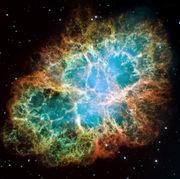
Crab Nebula.
Supernovae exploding in other galaxies are currently attracting a lot of attention because they are used to refine the Hubble constant and the geometry of the Universe. For this purpose, type Ia supernovae are selected as "standard candles". However, in distant galaxies, it is difficult to determine the type of star that existed before the explosion. Determining the type of exploding star would help refine the evolutionary models of stars.
In this work, unlike existing models, it is assumed that space-time is material, that is, it is capable of participating in energy exchange. If in generally accepted models the final stage of the evolution of massive stars is a red supergiant, and it should explode as a supernova, then in our model, the final stage will be the explosion of a blue hot star. Studying photographic plates obtained before the explosion of supernova 1987A showed that a blue supergiant exploded.
If there is an influx of vacuum energy to a planet, star, star system, and this is calculated in this work, then the scenario of the evolution of stars in this model is very different from the scenarios in the generally accepted models.
What is a supernova?
Let's start with the official point of view.
A supernova is an event, an explosive end to stellar life, resulting from the collapse of the star's interior into a black hole or neutron star. Supernovae are thought to be the suppliers of heavy elements in the Universe. The elements necessary for life, oxygen, carbon, and heavier ones, are produced in the star by the process of nucleosynthesis. During the explosion of the star, these elements, along with the shell of the collapsing star, are ejected into the Universe, where they are reused in stars and planets.
Supernovae are extremely luminous during their explosions and can therefore be used as beacons to determine distances in the Universe.
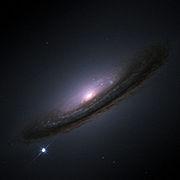
The bright star on the lower left in this photo beautifully illustrates that it is brighter than the billions of other stars that make up this distant galaxy.
Types of supernovae.
Supernovae are divided into two main types (I and II), depending on whether they have hydrogen lines in their spectra. Type I has no hydrogen lines. Further classification: Type Ia contains silicon absorption lines; Type Ib contains helium but no silicon lines; Type Ic has little silicon and little or no helium. Type II-L has a linear decline in luminosity over time; Type II-P has a flat spot on the luminosity graph lasting several weeks.
Type I supernovae are found in elliptical galaxies or in the bulges and halos of spiral galaxies. Type II supernovae are observed in the spiral arms of galaxies. Type I supernovae are typically two magnitudes brighter than Type II stars and decay more rapidly. Type II explosions are usually less bright and typically contain plateaus in their luminosity curves.
The classification of supernovae is thought to be the result of different stellar explosive mechanisms. In a broad sense, type Ia is the result of a white dwarf exploding when its mass is replenished above the critical value. Type II explosions occur as a result of the gravitational collapse of the stellar core, which is a unique phenomenon for massive stars. Types Ib and Ic are also most likely associated with nuclear collapse occurring in a close binary system.
Supernova of 1987.
Supernova SN 1987A is a type II supernova. This supernova is the final stage of the star Sandulek -69о 202, (Sk1),living in the Large Magellanic Cloud, a satellite of our Galaxy. From archival photographs it was found that the star had approximately the following physical parameters:
Тef = 16000 K;
L = 1,3·105LSun;
M = (15-25)MSun;
R = 47RSun.
It is assumed that the star Sk1 was born about 11 million years ago. During this time, it gradually consumed its nuclear fuel: hydrogen, helium, carbon, oxygen, neon, silicon, turning into something like an onion, with the formation of an iron core in the center of the star:
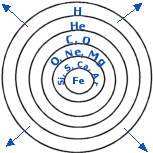
After the mass of the core of this star reached a critical value, about 1.4 solar masses, the core began to contract, to collapse. This resulted in the subsequent explosion of the star and the ejection of the shell.
The explosion of the star occurred approximately 168 thousand years ago, and we saw it when the light from the explosion reached Earth, on February 23, 1987.
An unexpected result.
Until 1987, it was almost a truism that the Universe evolves. According to this point of view, stars have no energy sources other than nuclear ones. Therefore, it is quite natural that after these sources are exhausted, a massive star becomes a red giant and explodes. This has already entered as an observational fact in all astronomy textbooks, although until 1987 no one could actually identify which star explodes as a supernova.
And lo and behold, a miracle! Astronomers have discovered that the predecessor of SN 1987A was not a red, but a blue supergiant.
Hurray!!!!!! We the stationarists have won! We did say that red supergiants are young stars, and blue ones are old.
But there was little to celebrate. The bigbangers made a loop on their graphs and said that just before the explosion, the red supergiant turned blue. That's all!
Was there a gravitational wave?[1]
Gravitational antenna in Rome, working at room temperature. According to modern concepts, an asymmetric collapse or supernova explosion should be accompanied by gravitational radiation. The analysis of the results of the Rome gravitational antenna was carried out in connection with the effect in the LSD detector during the explosion of the supernova SN 1987A. The analysis showed that the antenna registered an increase in energy by about 6 times relative to the average noise at 2:52:35.4 +/- 0.5 s UT. This is 1.4 +/- 0.5 s ahead of the first pulse in a packet of 5 pulses measured by LSD. The authors of the work claim that no electromagnetic or seismic interference was recorded at this time. The frequency of imitation of the measured configuration of events by the background is 1 time per 2 hours...
Note that an attempt to link the pulse recorded by the Roman antenna at 2:52 UT on 23.2.87 with the supernova SN 1987A outburst yields an energy that is at least hundreds of times greater than the energy of gravitational radiation during a standard collapse. Thus, it is clear that interpreting the effects observed by the detector group on 23.2.87 as the recording of neutrino or gravitational radiation during the collapse of a star in the LMC encounters great difficulties. First of all, the energy of neutrino radiation is at least an order of magnitude greater than the binding energy of a neutron star. In addition, there is still no satisfactory explanation for the "two-stage" collapse (2:52 UT and 7:35 UT) and the contradictions in the results of the three detectors near 7:36 UT...
Three neutrino detectors LSD, KII and IBM, located at different ends of the globe, registered short pulse trains on February 23, 1987. Each of these pulses satisfies all the criteria for registering neutrino interaction in the detector. During the detectors operation of 2.5 - 4 years, such pulse trains had never been observed. A few hours later, astronomers visually recorded a Supernova outburst in the Large Magellanic Cloud. The frequency of random correlation of these events is less than once per thousand years for any of the three detectors.
Interpretation of the 23.02.87 effect in any of the three neutrino detectors as a registration of neutrino radiation from the gravitational collapse that led to the formation of the Supernova in the LMC encounters great difficulties within the framework of the modern theory of collapse...
[3]...The physicists working on the neutrino detectors were not usually quick to send out teletexts in pursuit of priority, although in fact they were observing the signals in a timely manner. But then the telephone and other channels started working at full speed - and quite effectively. They said that the Mont Blanc group called their friends in Rome, said that they had detected a neutrino pulse from a new SN, and asked them to look at their gravitational wave detectors. ...the Rome group realized that they had an old gravitational wave detector that worked at room temperature - and they detected the signal at about the same time (1.4+/-0.5 sec earlier) as the Mont Blanc group!
Considering that the frequency of imitation of the measured configuration of events by the background is 1 time in 2 hours, and since the event was "pulled out" after a phone call, the credibility of the result of the registration of the gravitational wave is too weak. Nevertheless, in two hours there are as many as 120·60 seconds, and a coincidence of one second must be taken into account. The time sweep of the GeoGrav antenna signals and the neutrino flash from LSD is given in the article [3].
So what kind of collapse occurred in the depths of SN 1987A, into a neutron star, into a black hole, or into a magnetic hole?
The magnetic hole is my invention of 2008. And then, immediately after the discovery of SN 1987A, due to the fact that neutrino observatories registered two bursts of neutrino radiation, with a time difference of 4 hours 43 minutes, different versions were put forward.
a) That the first registration was erroneous, associated with some local event.
b) That the collapse of the star was double.
[3] Hillebrand et al. and De Rouhula have suggested that the events observed at Mont Blanc are neutrinos from the formation of a neutron star, and that the Kamiokande/IMB flare is associated with the formation of a black hole 4h43m later.
Mysterious spot - satellite SN 1987A?
[3] Karovska et al. of the Center for Astrophysics in Boston reported finding a bright feature 57 milliseconds away from the supernova. They used speckle interferometry on the 4-meter telescope at the Cerro Tololo Inter-American Observatory.
The observations were made on March 25 and April 2, i.e. on the 30th and 38th days. An angular distance of 57 milliseconds corresponds to approximately two light weeks, if the direction to the satellite is at right angles to the direction to the Earth; at other angles the distance is greater. The bright spot had a stellar magnitude of about 6.5 and did not exist before the explosion of SN 1987A, since it is 5 stellar magnitudes brighter than any object observed there before. This means that the bright spot is associated with SN 1987A, but judging by the timing, the speed required to travel from the Supernova to the spot must be greater than 0.4 times the speed of light. This seemed very surprising, but 10 days later, Matcher et al. of Imperial College, London, reported that they had also observed a second source at about the same location with the Anglo-Australian Telescope on 14 April, the 50th day. In both cases, the wavelengths used were Hα 656-658 nm, and the bright spot was about three magnitudes fainter than the supernova.
These two observations of a new bright source and the tangential velocity of 0.4c were unexpected. Somewhat reassuring was the famous case of SS 433, where, as established by observations in the H, X-ray and radio ranges, two jets are emitted in opposite directions with a velocity of 1/4 c...
Assuming that the bright spot exists, two important questions arise:
a) Is its luminosity constant, or did it flare up for only a few months?
b) Is it stationary, or is it moving away?
The Astrophysics Center measurements gave 59 +/- 8 arc msec on the 30th and 38th days, and Imperial College - 74 +/- 8 arc msec on the 50th day. This difference of 15 +/- 11 milliseconds is consistent with zero, i.e. with the absence of motion, but it was also interpreted as an indication that the source is gradually moving away from SN 1987A; the observational data are consistent with this...
Many theoretical papers propose mechanisms to explain...
a) The pulsar emits a plasma beam through a window in the shell, which generates a jet.
b) The dim satellite is heated by radiation from the SN...
c) The star is torn in two by the supernova explosion.
d) A gas cloud is emitted by the pre-supernova before the explosion.
d) The effect is created by a gravitational lens...
e) By analogy with SS 433, Colgate et al. suggest that the shock wave tears out a "magnetic jet" from the shell, which gradually loses its strength...
You can add here:
The inhabitants of the planet near the star Sanduleak have already conducted experiments on their collider and they all are already flying avay in many huge ocean water lumps. The water lumps transforms into foam in the absence of pressure and turn into even more huge foam-snow blocks, comets made from water, foam, dirt and seeds of life. That mysterious spot, mentioned above, is precisely the shell of the planet, flying away from Sanduleak at relativistic speed. Some of the plant seeds, and seeds of female ovaries and male testicles will survive and clash after falling into the warm lakes of distant planets, where orangutans and chimpanzees make love right in the water. The life is eternal in the eternal Universe.
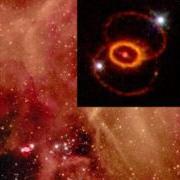
[7]The origin and nature of the beautiful rings surrounding the exploded star are still a mystery. Measurements have shown that they are expanding slowly, "only" 70,000-100,000 miles per hour (this is considered slow, since supernova remnants ejected from the center fly at 100-2,000 times that speed!). Spectroscopic observations show that the rings are enriched in nitrogen. The low speed and unusual chemical composition indicate that the rings were ejected from a pre-supernova more than 20,000 years ago...
...
...
More on the topic of this column read on my Russian-language page.
 24 09 1994
|
